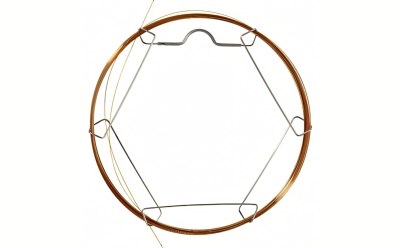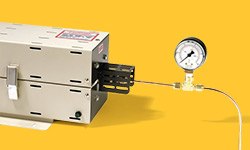GC Columns, Accessories & Adsorbents
Gas chromatography (GC) is a chromatographic technique used for the rapid separation of volatile compounds using an inert carrier gas (mobile phase). The mobile phase drives the gaseous compounds through the heated column which is coated with a solid or liquid stationary phase. The differences in the chemical and physical properties of the vaporized compounds and their interactions with the stationary phase are the basis of the separation process.
Products
Related Resources
- Application Note: Rapid and Efficient Esterification Process for FAME Profiling of Vegetable Fixed Oils and Fats
The objective of this application note is to develop and validate a simple, safe, and complete altenative esterification method that is highly accurate, consistent, and capable of parallel processing for esterification of multiple vegetable oil and fat samples and also has applicability in quality control (QC) process.
- Guide: GC Columns for USP Compendial Methods
This poster lists the USP Codes for the GC phases and supports used in these methods, descriptions, and information about our products that conform to these descriptions.
- Article: SupraSolv® GC Solvent Specifications
Our GC solvents have been specially developed and tested for ECD, FID and MS detection or for headspace gas chromatography to ensure accurate, reliable and reproducible analytical results.
- Brochure: GC Workflow
We provide a comprehensive range of high quality tools for each step of the GC workflow ensuring accuracy, precision and consistency of your analysis.
- Brochure: GC Columns Selection Guide
An optimized chromatographic separation begins with the column. The selection of the proper capillary column for any application should be based on four significant factors: stationary phase, column I.D., film thickness, and column length.
- Brochure: GC Solvents
As the world’s leading supplier of high-purity solvents, we offer a full range of products for every gas chromatography application in the laboratory - including highly sensitive pesticide and dioxin analyses.
- Brochure: GC Accessories
Choosing the proper items for routine system maintenance and new column installation can save costly downtime and rework, plus help prevent inaccurate chromatographic results.
- Guide: Environmental & Agricultural GC Columns Selection Guide
We have developed the most extensive line of special purpose columns designed for industry specific applications. These columns are manufactured to deliver high resolution, great analyte response, low bleed, and long column life to achieve the analytical performance you require.
- Flyer: Determination of Benzene in Reformulated Gasoline
The amount of benzene in gasoline is a concern because it is a known human carcinogen, and exposure to it has been linked to detrimental health effects.
- Application Note: GC-FID Method with Nitrogen as Carrier Gas for Simple-Routine Analysis of Essential Oils
The research examines nitrogen (N2) as an alternative to helium for GC-FID analysis of bergamot essential oil. By increasing nitrogen's velocity to 20 cm/s, analysis times comparable to helium were achieved, successfully quantifying 67 terpenes in 47 minutes with an optimized peak attribution model.
- Application Note: Hydrogen as Carrier Gas: A Reliable GC-MS Method for the Qualitative Analysis of Essential Oils
This research is focused on the development of a gas chromatography-mass spectrometry (GC-MS) method for the analysis of essential oils by using hydrogen (H2) as carrier gas.
- Brochure: Watercol™ Capillary GC Columns - Convenient Analysis of Water
Watercol™ 1910 is a specialized ionic liquid column designed for gas chromatography, particularly effective for moisture analysis.
GC Columns
An improved chromatographic separation begins with the selection of the appropriate column. In GC, two types of columns are available: capillary columns and packed columns.
Packed GC Columns
Packed GC columns consist of stainless steel, PTFE, or glass tubing filled with packing material (stationary phase). Packed columns can handle larger sample volumes and are not susceptible to contamination. Glass columns are used for applications requiring high inertness, metal columns are utilized for less demanding applications, and PTFE columns are preferred for low temperature applications.
Capillary GC Columns
Capillary GC columns are best suited for highly sensitive assays. Capillary columns consist of a thin, fused silica glass tube in which the stationary phase is chemically bonded or coated to the inner column surface.
Non-polar GC columns are best suited for the analysis of non-polar compounds (e.g. alkanes). Equity®-1, Petrocol®, SPB®-1, SPB®-Octyl, and SLB®-5ms are highly recommended products for the separation of non-polar compounds. Polar GC columns are most efficient at separating polar analytes. SPB®-624, OVI-G43, SPB®- 20, Equity®-1701, SPB®-35 SPB®-50, SPB®-225, PAG, SPB®-1000, SLB®-IL60i, and Nukol™ are some of the polar columns that provide the best separation of polar compounds.
Highly polar columns include those that contain stationary phases with a higher percentage of cyanopropyl functional groups. These phases exhibit a variety of interactions amenable to the separation of polarizable compounds. Polarizable compounds are those containing C and H, but with one or more C=C or C≡C bonds. Highly polar capillary columns include SP®-2330, SP®-2331, SP®-2380, SP®-2560, SP®-2340, TCEP, SLB®-IL111i.
GC accessories
GC accessories suitable for common GC instruments include GC septa, inlet liners, inlet seals, ferrules, nuts, guard columns, connectors, flowmeters, hand tools, syringes, vials, and photoionization detector (PID) lamps.
Gas Purification and Gas Management
A gas delivery system must supply a mobile phase gas of high purity at a suitable pressure based on its intended use. We offer products that purify and manage the gas stream (He, H, N, Ar), including purifiers, plumbing and regulation products, and gas generators, and air compressors.
Carbon GC Adsorbents
We offer highly engineered carbon absorbents (Carbosieve®, Graphsphere™, Carbotrap®, and Carbopack™) and several commonly used molecular sieve and porous polymer adsorbents for GC analysis. Key features of our carbon adsorbents include:
- Hard and non-friable
- Highly porous
- Hydrophobic in nature hence suitable for humid environments
- Used for molecules with an analyte size relative to C2-C5 n-alkanes
To continue reading please sign in or create an account.
Don't Have An Account?


